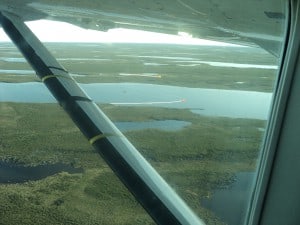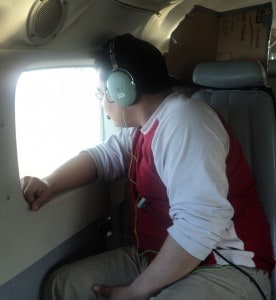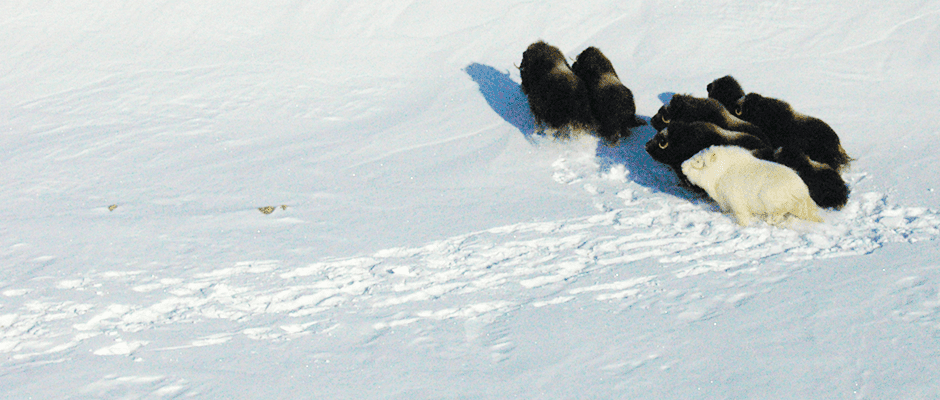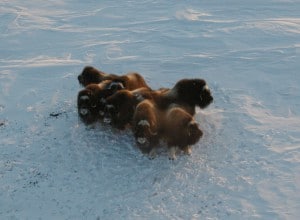Share this article
Muskox Populations Expand in Western Hudson Bay
There were miles and miles of rolling hills, wetlands so clear you could see fish in the lake from the plane and shrubby tundra with patches of green. Rocky areas were covered in yellow and orange lichens and occasionally Mitch Campbell could see glacial moraines, waterfalls and a whole ecosystems complete with polar bears (Ursus maritimus), grizzlies (Ursus arctos horribilis), waterfowl, caribou (Genus rangifer) and the occasional wolverine (Gulo gulo).

The view from a plane flying over Nunavut — the different tape markings represent different distances used in counting muskox. Image credit: Mitch Campbell
“There’s a beauty out there that just touches your soul. It’s more than eye candy,” said Campbell, a biologist with the Nunavut Department of Environment (NDE). But while only a handful of people in the world will probably ever see those kinds of landscapes, Campbell wasn’t along for a pleasure ride. He was in a small plane flying 600 feet above the ground surveying muskox (Ovibos moschatus) populations in the Kivalliq region of Nunavut, and overall things looked promising.
“Clearly the population estimate has increased,” said David Lee at a presentation at The Wildlife Society’s 2015 Conference in Winnipeg, “but they are likely more susceptible to area extirpation.”
Muskox populations suffered from serious declines in the late 1800s and early 1900s when the large northern animals were being overharvested for their hides to make up for the demand created by the decline of American bison (Bison bison). Whale ship crews would also harvest the animals during the off season in Hudson Bay for their meat and pelts. Muskox numbers declined in the area of western Hudson Bay until there weren’t many left, most of them confined to the Thelon Peninsula. The area was eventually protected to conserve the species there, and the muskox population slowly began to recover, to the point where the population doubled from 1999 to 2010, according to Lee, a wildlife biologist with Nunavut Tunngavik Inc. and a TWS member.
“It’s quite a positive story,” he said, adding that it’s good news for conservation biologists as well as the Inuit who harvest the animals in the region.
Surveying the North
To make sure they were getting accurate numbers, the surveys involved four different counters staring out at the empty landscape for an average of seven hours at a time from both sides of the plane. The observers looked out of windows on either side while the plane flew along transects.

Robert Karatak observing muskox during a survey in the central Kivalliq region of Nunavut. The cardboard partition behind his head separates him from another observer. Image credit: Mitch Campbell
But not all observers are created equal, and Campbell said that they created a system of checks to make up for the likelihood of someone missing a muskox. The two pairs were separated by cardboard partitions so that they couldn’t take visual cues from each other. This way they could also get an accurate estimation of an individual observer’s abilities — if one observer always tended to miss groups of two or three, they could use statistics to make the counts more accurate. It can also tell if some people are more prone to sleeping or daydreaming during the long survey flights, and can make corrections for areas where visibility is less than optimal due to weather conditions or other issues.
“If you can determine how good someone is, and figure out how many animals they are potentially missing, you can fill in those blanks,” Campbell said.
But for Campbell, daydreaming is never an issue when the landscape is so fantastic. “Every second that you look out that window, it’s something different. It’s a different nuance, it’s a different fold,” he said. “It makes you feel very small, very insignificant. But it’s a real privilege to be out there in this landscape.”
But while the numbers of muskox have been increasing overall, Campbell and Lee said there have been some shifts in habitat, with the animals becoming extirpated in certain areas. Campbell said it’s unclear why this is happening but it could have to do with increasing predator numbers.
Lee said that lots of grizzlies have been spotted during surveys in areas where there are low numbers of muskox calves, and less grizzlies seen in areas with high numbers of calves. The evidence about a possible link here is far from clear, though, and Campbell said the distribution changes might even signal the ecosystem has returned to some of its historic function.
“We don’t know a lot about muskox,” Campbell said. “Now they’re back and doing things that may be normal to them but new to us.”
A Local Connection
Aside from researchers like Campbell and Lee, local stakeholders from the hunting and trapping organizations in communities like Baker Lake and Chesterfield Inlet near the area helped with the surveys. “That way it’s not just a bunch of scientists trying to push their ideas on the people,” Campbell said. “The hunters can see it for themselves.”
He added that this was critical to keep a high level of respect between the Nunavut government and the locals, who will be able to better understand the reasoning behind management decisions on harvesting limits set by the NDE.
“People care deeply about [muskox conservation]. They hunt them for sure, but they want to make sure they’ll always be there. The pleasure in working with people in Nunavut is that the people really care about wildlife.”
Header Image:
Muskox, including a rare albino, seen from a helicopter on Ellesmere Island.
Image Credit: Mitch Campbell









